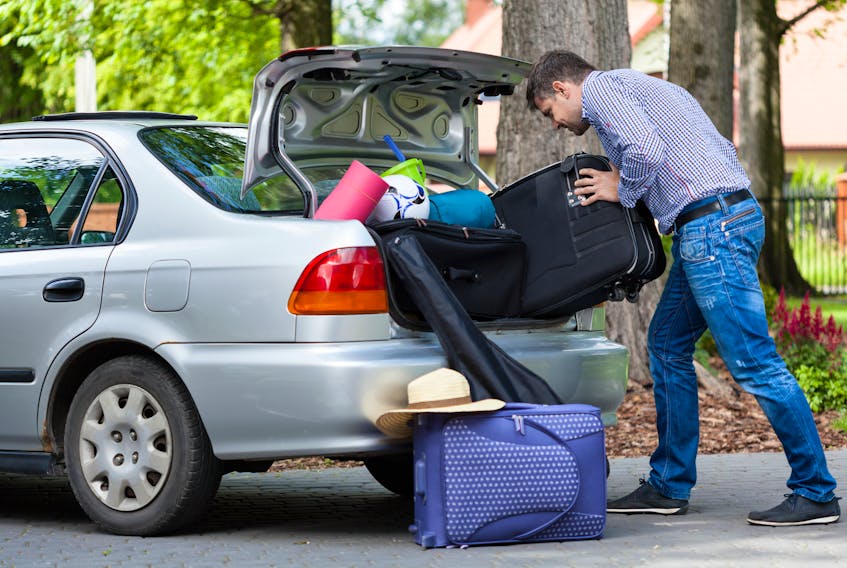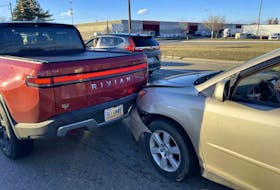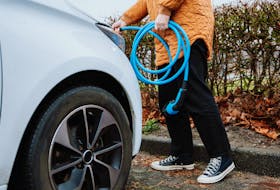A large number of vehicles on today’s roads are overloaded. I’m not referring to big commercial trucks or rigs. I mean family vehicles, especially those loaded up for a vacation or weekend at the cottage. It is astounding how many people are unaware of the capacity of their vehicle, especially those driving SUVs, minivans and pickups.
Most drivers assume their vehicle can carry all they can cram aboard. But some vehicles are near capacity with only passengers aboard. It is not uncommon for a popular SUV to have a payload capacity of 1,000 lbs. But, let’s say the driver weighs 200 lbs., his mate 150 and they have a pair of big suitcases weighing 75 lbs. each. That leaves 250 lbs. — about enough for one more person and their luggage. But if the vehicle is a fully-loaded luxury model, it may already be over the limit. How? Let’s look at the various terms. (in pounds since ratings are given in those terms).
CURB WEIGHT — The weight of the base vehicle. Includes fluids etc but not options ordered with the vehicle or installed by the dealer, (a fully loaded luxury version of a vehicle with leather etc can weigh as much as 500 or 600 lbs. more than the listed curb weight.
GVWR — Gross vehicle weight rating. The combined total of the vehicle and contents. If you are towing, don’t forget to add the tongue weight of the trailer to the tow vehicle’s Gross Weight. If you can’t find a scale, whether you are towing a boat, camper or five-bedroom home add another 200-1,000 lbs. for the stuff in that towed vehicle — plus passengers, plus luggage, plus golf clubs etc. For example, a big jug of water can add a couple hundred pounds
GAWR — Gross allowed weight rating. The maximum weight of the vehicle and contents, including passengers. Usually broken into separate ratings for the front and rear axles of a vehicle indicating how weight should be distributed to maximize braking.
GCWR — Gross combined weight rating. GCWR is the maximum allowable combined weight of the tow vehicle and the trailer — including all material, equipment, and passengers, dogs, purses etc.
Both GAWR and GCWR will exceed the GVWR. The towing vehicle’s brakes are rated for the GVWR. Separate functioning brakes should be used for safe control of towed vehicles weighing more than 1,000 lbs.
PAYLOAD — GVWR minus curb weight — the maximum weight a vehicle should carry.
Be very careful about the tongue weight of the towed vehicle. Too much and it can place an added load on the rear of the tow vehicle, lifting some weight off the front, creating less traction for the front tires which do the steering, and much of the braking. Generally speaking, for trailers up to 2,000 lbs. — up to 200 lbs. of tongue weight, for those over 2,000, 10 to 15 per cent of the trailer’s actual weight — loaded. For fifth-wheel setups that changes to about 25 per cent of loaded trailer weight. While you may have trouble finding a scale to weigh the whole rig, you can place the tonque of the trailer — with the hitch at towing height — on a scale.
Ensuring the trailer is packed correctly to stay within rated load and tongue limits is an art — one often forgotten in the last minute rush to hit the road. Tossing that big 100-lb. cooler into the very back — of either the tow vehicle or trailer can have a significant bearing on handling, braking and safety in emergency maneuvers.
Exceeding the load rating of your vehicle can not only void the warranty — it will be very dangerous. The vehicle has been designed to place a certain amount of weight on each tire. The way that weight is distributed determines the efficacy of the steering, suspension and brakes. And that weight will shift around in an emergency maneuver leading to situations virtually guaranteed to cause a Maalox moment!
When packing a vehicle consider first what would happen to the package in a sudden maneuver. Where will it go? What will it hit? What is keeping it in place? A family pet can become a projectile in a sudden stop. A heavy box in the back will move forward with great velocity, objects stacked above seat level and left carelessly around in a trailer will move forward at the speed the vehicle was travelling until they hit something.
Study your owner’s manual or an information plate attached to the door frame or elsewhere on the vehicle giving information on tire pressures. That is the most common way to discover the weight rating. If you regularly carry heavy loads or many passengers, the load rating should be a factor in your purchase decision.
RELATED:









